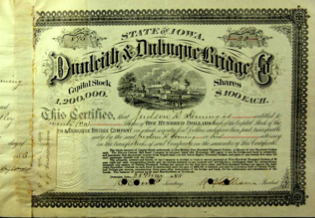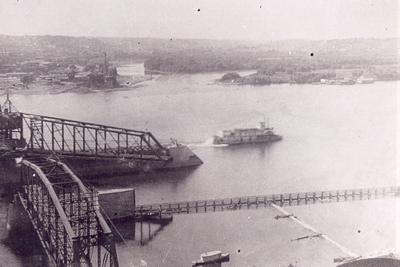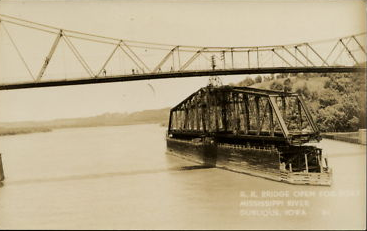Encyclopedia Dubuque
"Encyclopedia Dubuque is the online authority for all things Dubuque, written by the people who know the city best.”
Marshall Cohen—researcher and producer, CNN
Affiliated with the Local History Network of the State Historical Society of Iowa, and the Iowa Museum Association.
DUNLEITH AND DUBUQUE BRIDGE: Difference between revisions
No edit summary |
No edit summary |
||
| Line 17: | Line 17: | ||
[[Image:openbridge.jpg|left|thumb|350px|The bridge opens to allow river traffic to pass. Photo courtesy: Bob Reding.]] | [[Image:openbridge.jpg|left|thumb|350px|The bridge opens to allow river traffic to pass. Photo courtesy: Bob Reding.]] | ||
[[Image:bridge.png|right|thumb|250px|Postcard showing the swinging bridge.]] | [[Image:bridge.png|right|thumb|250px|Postcard showing the swinging bridge.]] | ||
In 1888, it was announced that the Dubuque stockholders of the railroad bridge had sold their two-thirds interest to the Illinois Central that already owned one-third. (9) The dual ownership had been a source of conflict. While both the Illinois Central and the stockholders had wanted other rail lines to be able to use the bridge, satisfactory terms could not be reached and other railroads were therefore shut out of Dubuque. | In 1888, it was announced that the Dubuque stockholders of the railroad bridge had sold their two-thirds interest to the Illinois Central that already owned one-third. (9) The dual ownership had been a source of conflict. While both the Illinois Central and the stockholders had wanted other rail lines to be able to use the bridge, satisfactory terms could not be reached and other railroads were therefore shut out of Dubuque. | ||
| Line 24: | Line 23: | ||
[[Image:railroadbridge.gif|left|thumb|250px|]] | [[Image:railroadbridge.gif|left|thumb|250px|]] | ||
Designed for the use of small steam engines, the bridge was never intended for heavy trains. In need of repairs by 1898, the bridge was renovated. The marsh area on the Iowa side of the bridge was filled, and the length of the bridge was shortened by 225 feet. (10) The bridge today remains generally the same as that which resumed business by 1900. | Designed for the use of small steam engines, the bridge was never intended for heavy trains. In need of repairs by 1898, the bridge was renovated. The marsh area on the Iowa side of the bridge was filled, and the length of the bridge was shortened by 225 feet. (10) The bridge today remains generally the same as that which resumed business by 1900. | ||
In 1985 the bridge was purchased from the Illinois Central by the Chicago Central and Pacific Railroad which was headquartered in Waterloo, Iowa. (11) It was the only railroad to use the bridge. It is later operated by Canadian National Railway as a result of their purchase of the Illinois Central in 1999. (Photo Courtesy: http://dubuque-tour.tripod.com) | |||
--- | --- | ||
| Line 49: | Line 50: | ||
10. Ibid. | 10. Ibid. | ||
11. Riddell, Amy. | |||
Revision as of 22:56, 10 November 2013
DUNLEITH AND DUBUQUE BRIDGE. Construction project, also known as the "Railroad Bridge", across the MISSISSIPPI RIVER in the late 1800s. Prior to the construction of the bridge, railroad cars, wagons, and travelers of the 1860s had to be carried across the Mississippi on FERRYBOATS. On the winter, brave men and women walked across the ice from Illinois to Iowa.
Hopes for a bridge across the Mississippi River began in 1857 when the Illinois legislature granted a charter to the Dunleith and Dubuque Bridge Company for the project. (1) Due to the CIVIL WAR, no action was taken on this project.
It was not until 1867 that the Dunleith and Dubuque Bridge Company was reorganized. (2) The first board of directors included William Boyd ALLISON, president; Henry L. STOUT, vice-president and treasurer; and Platt SMITH as one of the directors. All stock in the company was purchased in Dubuque, Boston, and New York.
When the company made application to the City of Dubuque to locate the western end of the bridge and gain right-of-way into the city, many citizens argued that the bridge should also offer a wagon-way. The Council refused to be delayed by these requests, however, and construction contracts were arranged.
Andrew CARNEGIE of the Union Iron Mills and the Keystone Bridge Company of Philadelphia eventually won the contract. (3) While not the lowest bidder for the work, Carnegie agreed to meet the lowest bid which had been made for the work to be done with cast iron. Carnegie had argued that such a structure would be weaker than wrought iron. He was supported in his argument by Platt Smith who reported that one of his wagon wheels had been able to break a cast iron street lamp post. (4) Work began on a bridge 1,760 feet long with seven spans and a 360-foot draw span that allowed river traffic to pass under the bridge.
A tunnel, blasted through the East Dubuque cliffs provided an approach to the bridge, and rock from the tunnel was used for bridge supports. Pilings for the bridge were driven through the ice and into the streambed. The work on the bridge was completed in December, 1868 and the first train operated by the DUBUQUE AND SIOUX CITY RAILROAD passed over it.
The completed bridge was about one-fourth the length of the Golden Gate Bridge near San Francisco. (5) The 359 foot long drawspan that rotates, moves on forty cast iron rollers each weighing five hundred pounds. (6) The power to rotate the bridge in 1987 was supplied by a 30-horse power electric engine. (7) The cost of the bridge was $570,900 considerably less than $1,200,000 anticipated by the bridge officials. The total cost, however, including track laying and approach construction raised the final cost to $1,050,643.49. (8)
The bridge was officially opened on New Year's Day, 1869.
In 1888, it was announced that the Dubuque stockholders of the railroad bridge had sold their two-thirds interest to the Illinois Central that already owned one-third. (9) The dual ownership had been a source of conflict. While both the Illinois Central and the stockholders had wanted other rail lines to be able to use the bridge, satisfactory terms could not be reached and other railroads were therefore shut out of Dubuque.
The Illinois Central held a contract that called for an annual rental of $80,000 to be paid to the stockholders in addition to a fee for each car that crossed the bridge. The railroad, in purchasing the stockholders interest, stated its desire to lower this rate for itself as well as the other railroads that used the bridge. One immediate beneficiary of the new agreement was the Burlington and Northern Railroad that had to use a transfer boat to ferry its cars across the Mississippi.
Designed for the use of small steam engines, the bridge was never intended for heavy trains. In need of repairs by 1898, the bridge was renovated. The marsh area on the Iowa side of the bridge was filled, and the length of the bridge was shortened by 225 feet. (10) The bridge today remains generally the same as that which resumed business by 1900.
In 1985 the bridge was purchased from the Illinois Central by the Chicago Central and Pacific Railroad which was headquartered in Waterloo, Iowa. (11) It was the only railroad to use the bridge. It is later operated by Canadian National Railway as a result of their purchase of the Illinois Central in 1999. (Photo Courtesy: http://dubuque-tour.tripod.com)
---
Source:
1. Donovan, Frank P. Iowa Railroads: The Essays of Frank P. Donovan, Jr. Iowa City: University of Iowa Press, 2000 p. 109
2. Donovan, p. 109
3. Riddell, Amy. "These Men Work Swing Shift Around the Clock," Telegraph Herald, Feb. 24, 1987, p. 48. Online: http://news.google.com/newspapers?id=O5tdAAAAIBAJ&sjid=xlwNAAAAIBAJ&pg=3970,4443738&dq=dubuque+wagon+bridge+opening&hl=en
4. Donovan, p. 109
5. Riddell, Amy.
6. Ibid.
7. Ibid.
8. Donovan, p. 110
9. Ibid.
10. Ibid.
11. Riddell, Amy.





